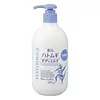What's inside
What's inside
 Key Ingredients
Key Ingredients

 Benefits
Benefits

 Concerns
Concerns

 Ingredients Side-by-side
Ingredients Side-by-side

Water
Skin ConditioningGlycerin
HumectantStearic Acid
CleansingGlycol Stearate
EmollientIsopropyl Palmitate
EmollientGlycine Soja Oil
EmollientGlyceryl Stearate
EmollientTriethanolamine
BufferingCocos Nucifera Oil
MaskingCetyl Alcohol
EmollientCaprylyl Glycol
EmollientPhenoxyethanol
PreservativeParfum
MaskingCarbomer
Emulsion StabilisingHydroxyethylcellulose
Emulsion StabilisingStearamide Amp
BHT
AntioxidantDisodium EDTA
Caramel
Cosmetic ColorantButyrospermum Parkii Butter
Skin ConditioningAvena Sativa Meal Extract
SoothingPropylene Glycol
HumectantSodium Nitrate
SoothingDisodium Phosphate
BufferingPolysorbate 60
EmulsifyingSodium Phosphate
BufferingCitric Acid
BufferingBenzyl Salicylate
PerfumingCitrus Aurantium Peel Oil
Coumarin
PerfumingHexyl Cinnamal
PerfumingLimonene
PerfumingTetramethyl Acetyloctahydronaphthalenes
MaskingCI 17200
Cosmetic ColorantCI 19140
Cosmetic ColorantCI 15985
Cosmetic ColorantWater, Glycerin, Stearic Acid, Glycol Stearate, Isopropyl Palmitate, Glycine Soja Oil, Glyceryl Stearate, Triethanolamine, Cocos Nucifera Oil, Cetyl Alcohol, Caprylyl Glycol, Phenoxyethanol, Parfum, Carbomer, Hydroxyethylcellulose, Stearamide Amp, BHT, Disodium EDTA, Caramel, Butyrospermum Parkii Butter, Avena Sativa Meal Extract, Propylene Glycol, Sodium Nitrate, Disodium Phosphate, Polysorbate 60, Sodium Phosphate, Citric Acid, Benzyl Salicylate, Citrus Aurantium Peel Oil, Coumarin, Hexyl Cinnamal, Limonene, Tetramethyl Acetyloctahydronaphthalenes, CI 17200, CI 19140, CI 15985
Water
Skin ConditioningGlycerin
HumectantDipropylene Glycol
HumectantMethyl Gluceth-10
EmulsifyingPEG/PPG/Polybutylene Glycol-8/5/3 Glycerin
HumectantButylene Glycol
HumectantSodium Hyaluronate
HumectantCoix Lacryma-Jobi Ma-Yuen Seed Extract
Skin ConditioningDipotassium Glycyrrhizate
HumectantXanthan Gum
EmulsifyingStyrene/Acrylates Copolymer
PEG-60 Hydrogenated Castor Oil
EmulsifyingCitric Acid
BufferingSodium Citrate
BufferingPhenoxyethanol
PreservativeMethylparaben
PreservativePropylparaben
PreservativeWater, Glycerin, Dipropylene Glycol, Methyl Gluceth-10, PEG/PPG/Polybutylene Glycol-8/5/3 Glycerin, Butylene Glycol, Sodium Hyaluronate, Coix Lacryma-Jobi Ma-Yuen Seed Extract, Dipotassium Glycyrrhizate, Xanthan Gum, Styrene/Acrylates Copolymer, PEG-60 Hydrogenated Castor Oil, Citric Acid, Sodium Citrate, Phenoxyethanol, Methylparaben, Propylparaben
Ingredients Explained
These ingredients are found in both products.
Ingredients higher up in an ingredient list are typically present in a larger amount.
Citric Acid is an alpha hydroxy acid (AHA) naturally found in citrus fruits like oranges, lemons, and limes.
Like other AHAs, citric acid can exfoliate skin by breaking down the bonds that hold dead skin cells together. This helps reveal smoother and brighter skin underneath.
However, this exfoliating effect only happens at high concentrations (20%) which can be hard to find in cosmetic products.
Due to this, citric acid is usually included in small amounts as a pH adjuster. This helps keep products slightly more acidic and compatible with skin's natural pH.
In skincare formulas, citric acid can:
While it can provide some skin benefits, research shows lactic acid and glycolic acid are generally more effective and less irritating exfoliants.
Most citric acid used in skincare today is made by fermenting sugars (usually from molasses). This synthetic version is identical to the natural citrus form but easier to stabilize and use in formulations.
Read more about some other popular AHA's here:
Learn more about Citric AcidGlycerin is already naturally found in your skin. It helps moisturize and protect your skin.
A study from 2016 found glycerin to be more effective as a humectant than AHAs and hyaluronic acid.
As a humectant, it helps the skin stay hydrated by pulling moisture to your skin. The low molecular weight of glycerin allows it to pull moisture into the deeper layers of your skin.
Hydrated skin improves your skin barrier; Your skin barrier helps protect against irritants and bacteria.
Glycerin has also been found to have antimicrobial and antiviral properties. Due to these properties, glycerin is often used in wound and burn treatments.
In cosmetics, glycerin is usually derived from plants such as soybean or palm. However, it can also be sourced from animals, such as tallow or animal fat.
This ingredient is organic, colorless, odorless, and non-toxic.
Glycerin is the name for this ingredient in American English. British English uses Glycerol/Glycerine.
Learn more about GlycerinPhenoxyethanol is a preservative that has germicide, antimicrobial, and aromatic properties. Studies show that phenoxyethanol can prevent microbial growth. By itself, it has a scent that is similar to that of a rose.
It's often used in formulations along with Caprylyl Glycol to preserve the shelf life of products.
Water. It's the most common cosmetic ingredient of all. You'll usually see it at the top of ingredient lists, meaning that it makes up the largest part of the product.
So why is it so popular? Water most often acts as a solvent - this means that it helps dissolve other ingredients into the formulation.
You'll also recognize water as that liquid we all need to stay alive. If you see this, drink a glass of water. Stay hydrated!
Learn more about Water